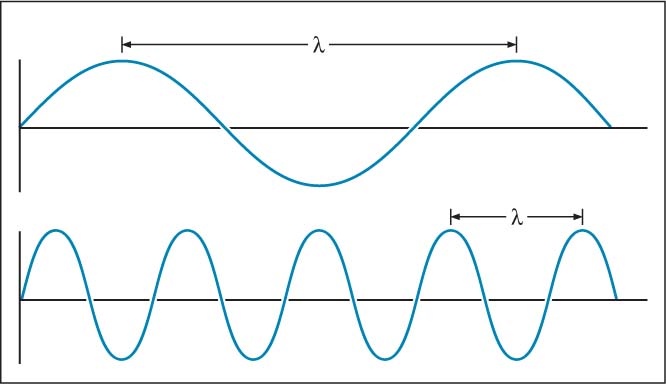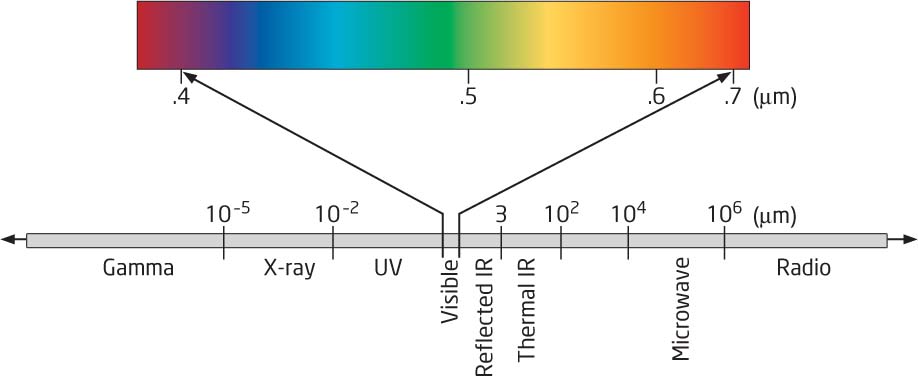10.1 
What Is Remote Sensing Actually Sensing?

wavelength the distance between the crests of two waves
The information that is being sensed is the reflection of electromagnetic (EM) energy off a target. There are two ways of thinking of light energy: as a particle or as a wave. For our purposes, we’ll stick to the concept of light energy as a wave. When the Sun radiates light energy, it radiates in the form of waves. Think of it like sitting on the beach and watching the ocean waves come in and crash on the shore. The distance between the crests of two waves is called the wavelength (λ)—some wavelengths are very long, and some are very short. If it’s a calm day at the ocean, you see waves less frequently than on a rough day—there will be a longer distance between waves (and therefore a longer wavelength). If it’s a rough day on the ocean, you’ll see waves a lot more frequently, and the distance between waves will be shorter (that is, a shorter wavelength).
As we can observe, there’s a definite connection between wavelengths and the frequency of the waves themselves. With a longer wavelength, you’ll see waves far less frequently, and with a shorter wavelength, you’ll see the waves a lot more frequently (Figure 10.2). If you sit on the beach and count the waves, you’ll count a higher number of waves when the wavelength between them is small, and you’ll count fewer waves when the wavelength between them is longer.

330
Waves of energy work on a similar principle. Energy travels at a constant speed, that is, the speed of light (c), which is about 300 million meters per second. If you multiply the frequency by the wavelength, the result is always equal to the speed of light. When the value for the wavelength of light energy is high, the frequency is low, and if the value for the frequency is high, the value for the wavelength has to be lower to make the product of the two values always come out to the same number.
electromagnetic spectrum the light energy wavelengths and the properties associated with them
micrometer a unit of measurement equal to one-millionth of a meter. Abbreviated μm
nanometer a unit of measurement equal to one-billionth of a meter. Abbreviated nm
Electromagnetic energy at different wavelengths also has different properties. Light energy with very long wavelengths will have different characteristics from light that has very short wavelengths. The electromagnetic spectrum is used to examine the properties of light energy in relation to wavelength. The values of the wavelengths are usually measured in extremely small units of measurement called micrometers (μm): A micrometer is one-millionth of a meter (roughly the thickness of a single bacterium). Sometimes an even smaller unit of measurement is used, called a nanometer (nm), which is one-billionth of a meter. Forms of electromagnetic energy with very short wavelengths are cosmic rays, gamma rays, and x-rays, while forms of electromagnetic energy with very long wavelengths are microwaves and radio waves (Figure 10.3).

visible light spectrum the portion of the electromagnetic spectrum with wavelengths between 0.4 and 0.7 micrometers
UV (ultraviolet) the portion of the electromagnetic spectrum with wavelengths between 0.01 and 0.4 micrometers
It’s important to remember that the Sun radiates many types of energy, but they’re invisible to the human eye. When you put a slice of cold pizza in the microwave oven to heat it, you don’t actually see the microwaves bombarding the pizza. In the same way, you can’t see the x-rays that a doctor uses in an exam, or the radio waves that are picked up by your car’s antenna. All this energy is out there, but you just can’t see it. This is because the composition of your eyes (which are structured to respond to reflected energy) are only sensitive to the reflected light that has a wavelength between 0.4 and 0.7 micrometers. This portion of the electromagnetic spectrum is called the visible light spectrum or “visible spectrum” (see Figure 10.3 to see what portion of the whole electromagnetic spectrum is occupied by the visible light spectrum). If your eyes were sensitive to the reflection of slightly shorter wavelengths of energy, you’d be able to see ultraviolet (UV) light (as bees can), and if you could see longer wavelengths of energy, you’d be able to see infrared light. However, the human eye is only sensitive to electromagnetic energy in this very small range of wavelengths.
331
band a narrow range of wavelengths that may be measured by a remote sensing device
blue band the range of wavelengths between 0.4 and 0.5 micrometers
green band the range of wavelengths between 0.5 and 0.6 micrometers
red band the range of wavelengths between 0.6 and 0.7 micrometers
The visible spectrum can be broken down further to the colors that it comprises. Shorter visible light wavelengths (between 0.4 and 0.5 micrometers) represent the blue portion of the spectrum. Medium visible light wavelengths (between 0.5 and 0.6 micrometers) represent the green portion of the spectrum. Longer visible light wavelengths (between 0.6 and 0.7 micrometers) represent the red portion of the spectrum. When you see a bright red shirt, your eyes are actually sensing the reflection of light with a wavelength measurement somewhere between 0.6 and 0.7 micrometers.
Each of these narrow portions of the electromagnetic spectrum that represent a particular form of light is referred to as a band of energy in remote sensing. For example, the shorter wavelengths of 0.4 to 0.5 micrometers are referred to as the blue band of the electromagnetic spectrum, because the properties of those wavelengths of light correspond to the characteristics of blue energy. Wavelengths between 0.5 and 0.6 micrometers make up the green band of the electromagnetic spectrum, wavelengths between 0.6 to 0.7 micrometers make up the red band.
IR (infrared) the portion of the electromagnetic spectrum with wavelengths between 0.7 and 100 micrometers
Keep in mind that while the human eye is restricted to seeing only these narrow bands of the electromagnetic spectrum, remote sensing devices have the capability to sense energy from other sections of the spectrum. For instance, the infrared (IR) light portion of the electromagnetic spectrum covers wavelengths between 0.7 and 100 micrometers. A sensor could be tuned to measure only the reflection of infrared energy between 0.7 and 0.9 micrometers, and even though this energy is not visible to the human eye, the sensor would have no difficulty measuring this narrow band of reflected energy. As we’ll see, an enormous amount of information can be gained from examining these other forms of energy as they are reflected off objects. In remote sensing of infrared light, there are a few wavelength ranges that are utilized much more than the others:
NIR (near infrared) the portion of the electromagnetic spectrum with wavelengths between 0.7 and 1.3 micrometers
MIR (middle infrared) the portion of the electromagnetic spectrum with wavelengths between 1.3 and 3.0 micrometers
TIR (thermal infrared) the portion of the electromagnetic spectrum with wavelengths between 3.0 and 14.0 micrometers
 0.7 to 1.3 micrometers: Bands in this portion, referred to as “near infrared” (NIR), are frequently used in satellite remote sensing (see Chapter 11) and in color-infrared photography (see Chapter 9).
0.7 to 1.3 micrometers: Bands in this portion, referred to as “near infrared” (NIR), are frequently used in satellite remote sensing (see Chapter 11) and in color-infrared photography (see Chapter 9).
 1.3 to 3.0 micrometers: Bands of this portion, referred to as “middle infrared” (MIR), are also utilized by various other satellite sensors. For instance, measurements of bands of MIR energy are used regularly in studies related to the water content of plants.
1.3 to 3.0 micrometers: Bands of this portion, referred to as “middle infrared” (MIR), are also utilized by various other satellite sensors. For instance, measurements of bands of MIR energy are used regularly in studies related to the water content of plants.
 3.0 to 14.0 micrometers: Bands of this portion are referred to as “thermal infrared” (TIR), and are widely used for measuring heat sources and radiant heat energy.
3.0 to 14.0 micrometers: Bands of this portion are referred to as “thermal infrared” (TIR), and are widely used for measuring heat sources and radiant heat energy.
332